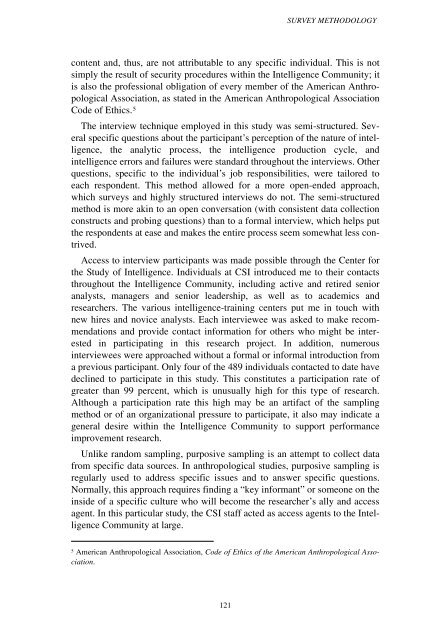Analytic Culture in the U.S. Intelligence Community (PDF) - CIA
Analytic Culture in the U.S. Intelligence Community (PDF) - CIA
Analytic Culture in the U.S. Intelligence Community (PDF) - CIA
You also want an ePaper? Increase the reach of your titles
YUMPU automatically turns print PDFs into web optimized ePapers that Google loves.
SURVEY METHODOLOGY<br />
content and, thus, are not attributable to any specific <strong>in</strong>dividual. This is not<br />
simply <strong>the</strong> result of security procedures with<strong>in</strong> <strong>the</strong> <strong>Intelligence</strong> <strong>Community</strong>; it<br />
is also <strong>the</strong> professional obligation of every member of <strong>the</strong> American Anthropological<br />
Association, as stated <strong>in</strong> <strong>the</strong> American Anthropological Association<br />
Code of Ethics. 5<br />
The <strong>in</strong>terview technique employed <strong>in</strong> this study was semi-structured. Several<br />
specific questions about <strong>the</strong> participant’s perception of <strong>the</strong> nature of <strong>in</strong>telligence,<br />
<strong>the</strong> analytic process, <strong>the</strong> <strong>in</strong>telligence production cycle, and<br />
<strong>in</strong>telligence errors and failures were standard throughout <strong>the</strong> <strong>in</strong>terviews. O<strong>the</strong>r<br />
questions, specific to <strong>the</strong> <strong>in</strong>dividual’s job responsibilities, were tailored to<br />
each respondent. This method allowed for a more open-ended approach,<br />
which surveys and highly structured <strong>in</strong>terviews do not. The semi-structured<br />
method is more ak<strong>in</strong> to an open conversation (with consistent data collection<br />
constructs and prob<strong>in</strong>g questions) than to a formal <strong>in</strong>terview, which helps put<br />
<strong>the</strong> respondents at ease and makes <strong>the</strong> entire process seem somewhat less contrived.<br />
Access to <strong>in</strong>terview participants was made possible through <strong>the</strong> Center for<br />
<strong>the</strong> Study of <strong>Intelligence</strong>. Individuals at CSI <strong>in</strong>troduced me to <strong>the</strong>ir contacts<br />
throughout <strong>the</strong> <strong>Intelligence</strong> <strong>Community</strong>, <strong>in</strong>clud<strong>in</strong>g active and retired senior<br />
analysts, managers and senior leadership, as well as to academics and<br />
researchers. The various <strong>in</strong>telligence-tra<strong>in</strong><strong>in</strong>g centers put me <strong>in</strong> touch with<br />
new hires and novice analysts. Each <strong>in</strong>terviewee was asked to make recommendations<br />
and provide contact <strong>in</strong>formation for o<strong>the</strong>rs who might be <strong>in</strong>terested<br />
<strong>in</strong> participat<strong>in</strong>g <strong>in</strong> this research project. In addition, numerous<br />
<strong>in</strong>terviewees were approached without a formal or <strong>in</strong>formal <strong>in</strong>troduction from<br />
a previous participant. Only four of <strong>the</strong> 489 <strong>in</strong>dividuals contacted to date have<br />
decl<strong>in</strong>ed to participate <strong>in</strong> this study. This constitutes a participation rate of<br />
greater than 99 percent, which is unusually high for this type of research.<br />
Although a participation rate this high may be an artifact of <strong>the</strong> sampl<strong>in</strong>g<br />
method or of an organizational pressure to participate, it also may <strong>in</strong>dicate a<br />
general desire with<strong>in</strong> <strong>the</strong> <strong>Intelligence</strong> <strong>Community</strong> to support performance<br />
improvement research.<br />
Unlike random sampl<strong>in</strong>g, purposive sampl<strong>in</strong>g is an attempt to collect data<br />
from specific data sources. In anthropological studies, purposive sampl<strong>in</strong>g is<br />
regularly used to address specific issues and to answer specific questions.<br />
Normally, this approach requires f<strong>in</strong>d<strong>in</strong>g a “key <strong>in</strong>formant” or someone on <strong>the</strong><br />
<strong>in</strong>side of a specific culture who will become <strong>the</strong> researcher’s ally and access<br />
agent. In this particular study, <strong>the</strong> CSI staff acted as access agents to <strong>the</strong> <strong>Intelligence</strong><br />
<strong>Community</strong> at large.<br />
5<br />
American Anthropological Association, Code of Ethics of <strong>the</strong> American Anthropological Association.<br />
121
















